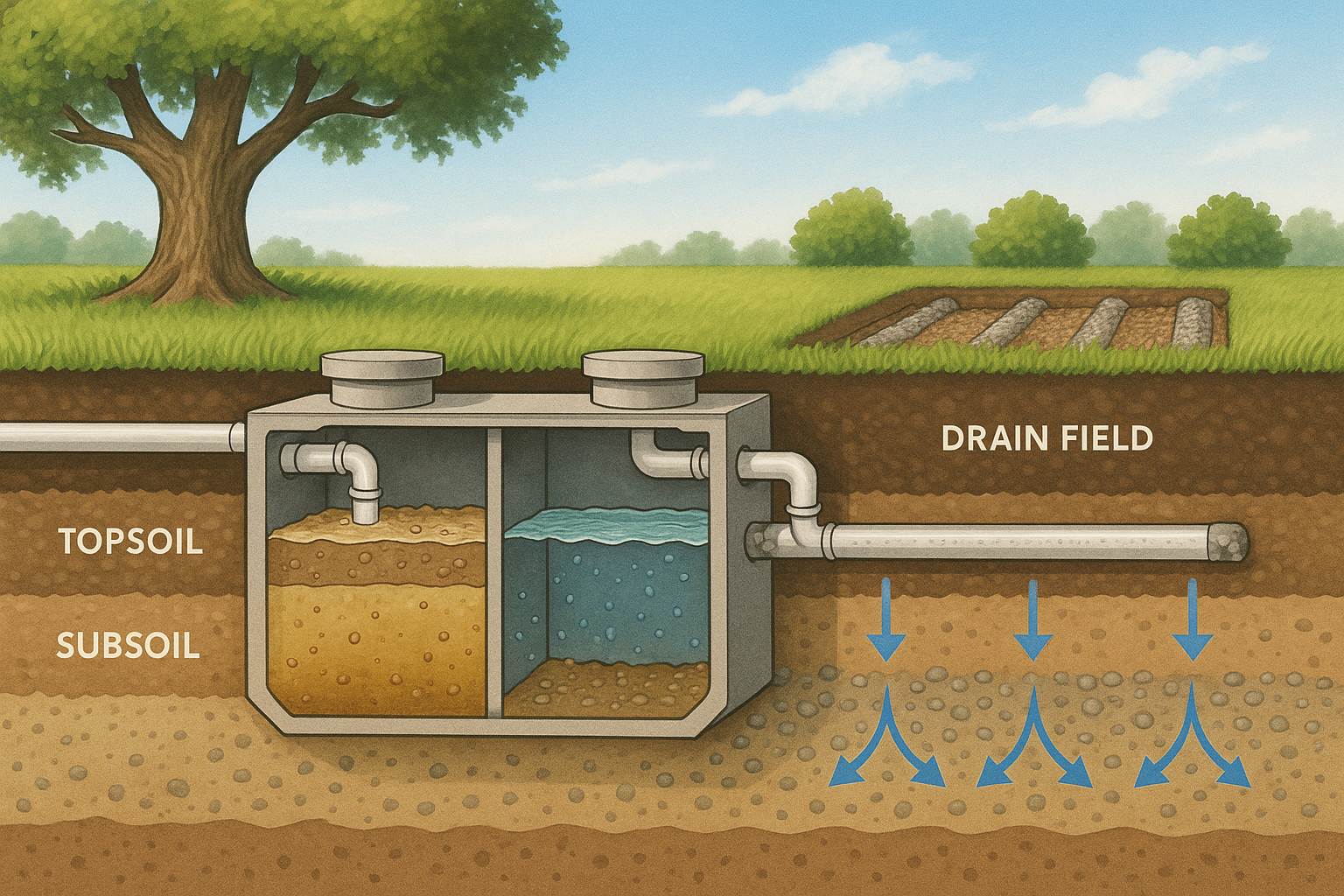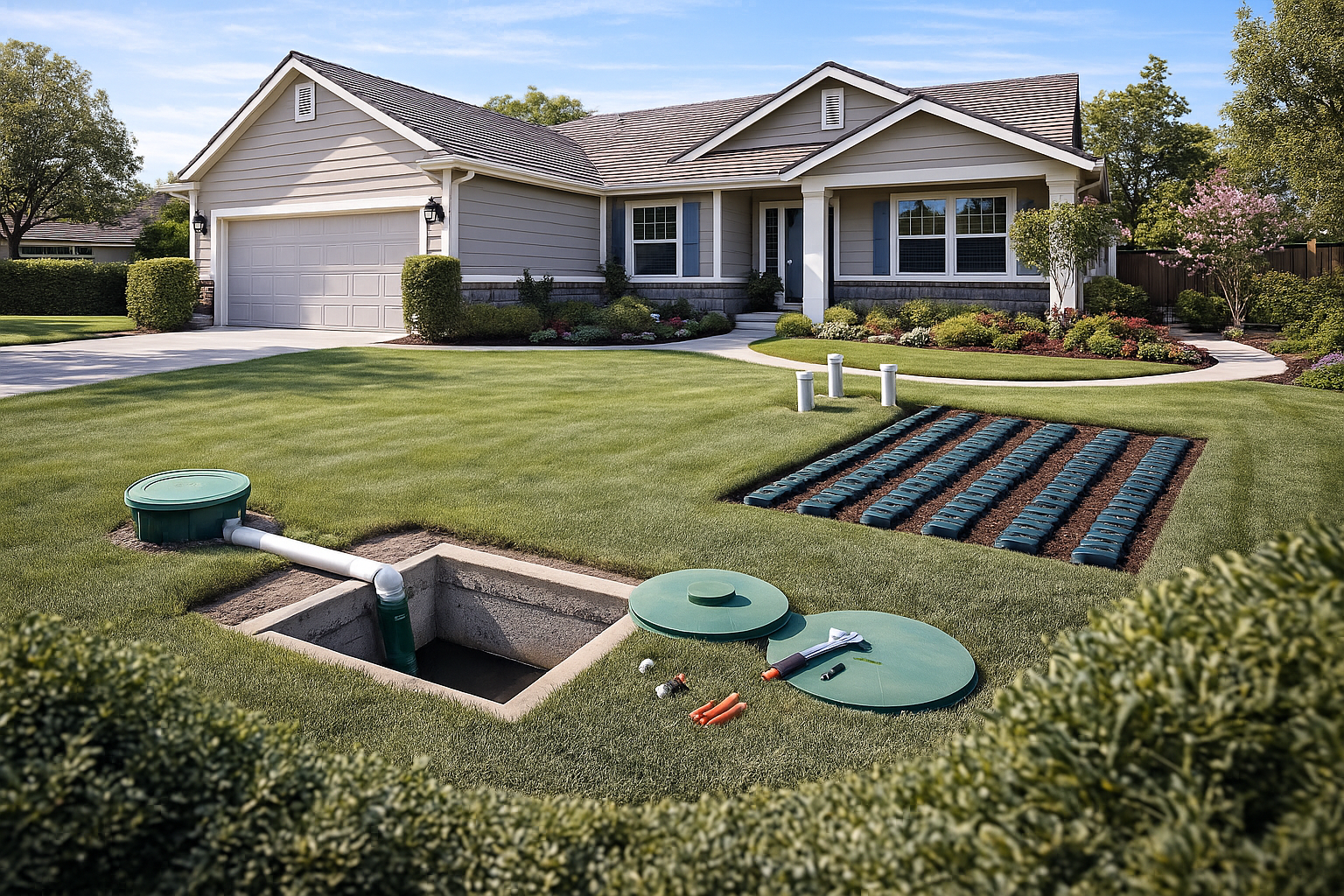A Homeowner’s Guide to Key Components and How They Work
Ever wondered what’s really happening underground when you flush your toilet? For homeowners in Sacramento, CA, understanding septic system components isn’t just about curiosity: it’s essential for preventing costly repairs and maintaining a healthy home environment. Many people rely on their systems daily without realizing how each part contributes to efficient waste management.
A septic system isn’t just a buried tank: it’s an ecosystem designed to treat wastewater naturally and efficiently. When one part fails, the entire system struggles. Knowing the components of septic system design helps you:
- Identify early warning signs of potential problems
- Plan maintenance before breakdowns happen
By the end of this guide, you’ll understand the main components of a septic tank system, how they function, and how to keep everything running smoothly.
Understanding the Basics of a Septic System
Before diving into each part, it’s important to understand what a septic system does. In simple terms, it’s an underground wastewater treatment structure used in areas without centralized sewer systems, common across suburban and rural Sacramento properties.
A well-functioning system safely treats wastewater from your home’s kitchen, bathroom, and laundry. Here’s why it matters:
- Protects groundwater and local ecosystems by filtering waste before it re-enters the soil, as outlined by the U.S. Environmental Protection Agency (EPA).
- Prevents costly repairs through early detection of septic tank components issues.
- Supports property value by maintaining reliable wastewater infrastructure, a factor noted by Forbes Home.
A septic system’s efficiency depends on balance. Too much water, grease, or harsh chemicals can overload it. That’s why understanding its septic tank system components is the first step to smart maintenance.
The Main Septic System Components Explained
Let’s explore each part of your system and its role in keeping your home’s wastewater treatment running smoothly.
The Septic Tank: Where Wastewater Begins Treatment
The septic tank is the heart of your system and one of the most vital components of a septic tank. It receives all wastewater from your home and separates it into three layers: scum (top), effluent (middle), and sludge (bottom).
Purpose: This separation allows solids to settle while bacteria begin breaking down organic matter.
How It Works:
- Waste enters the tank through an inlet pipe.
- Anaerobic bacteria decompose waste materials.
- Effluent flows out into the drain field for further treatment.
Pro Tip: Have your tank pumped every 3–5 years in Sacramento’s clay-rich soils to prevent overflow and maintain proper flow. Learn more about septic tank cleaning and pumping.
The Inlet and Outlet Pipes: Managing Flow and Direction
These small but essential components of septic system control wastewater direction. The inlet pipe carries waste from your home to the tank, while the outlet pipe sends treated liquid to the drain field.
Purpose: They maintain steady flow and prevent backflow.
How It Works:
- Proper slope ensures gravity-assisted movement.
- Baffles at both ends prevent solids from escaping.
Pro Tip: Keep heavy vehicles off your septic area, as pressure can damage pipes and restrict flow. If you suspect a problem, consider tank locating and outlet baffle replacement.
The Drain Field: The Final Filtration Stage
Often called a leach field, this underground network of perforated pipes filters effluent through soil layers.
Purpose: It naturally removes harmful bacteria, viruses, and nutrients from wastewater.
How It Works:
- Effluent seeps through gravel and soil layers.
- Microorganisms in the soil treat and purify the liquid.
Pro Tip: Avoid planting trees near the drain field, as roots can infiltrate and clog pipes. For system types and soil impact, explore different types of septic systems in Sacramento.
For more details on drain field care and maintenance, check out The Spruce’s homeowner guide.
The Distribution Box: Balancing Wastewater Flow
Not every system has one, but many modern designs do. The distribution box evenly disperses effluent across the drain field and is another key septic tank system component.
Purpose: Prevents overloading one section of the leach field.
How It Works:
- Wastewater enters from the septic tank.
- Outlets direct flow to multiple leach lines.
Pro Tip: Inspect this box annually: imbalances can cause uneven absorption and localized flooding.
The Soil: Nature’s Filter Beneath the Surface
While often overlooked, the soil itself is one of the most critical components of septic system design.
Purpose: It completes the treatment process through biological, chemical, and physical filtration.
How It Works:
- Soil particles trap pathogens and nutrients.
- Beneficial microbes break down contaminants.
Pro Tip: Don’t compact the soil above your drain field. Healthy aeration ensures optimal filtration. Read HomeAdvisor’s septic maintenance advice to keep your soil and system in top condition.
Practical Applications of Understanding Septic System Components
Once you know each part, you can better maintain it. Homeowners in Sacramento can use this knowledge to:
- Schedule Smarter Maintenance: Regular inspections of tanks, baffles, and pipes reduce repair costs by up to 30%. Book a real estate septic system inspection with a full report.
- Troubleshoot Faster: Recognize early signs such as slow drains or odors that may indicate a clog or imbalance.
- Plan Property Upgrades: Knowing your system layout helps avoid damaging underground parts during landscaping or construction.
In short, understanding your septic tank system components is like knowing your car’s engine: it keeps everything running smoothly and saves you money over time. Learn more about long-term maintenance and home value at BobVila.com.
Tips for Maintaining a Healthy Septic System
Proper care can extend your septic system’s lifespan beyond 25 years. Here’s how:
- Pump Regularly: Have a licensed professional pump your tank every 3–5 years to remove built-up solids.
- Watch What You Flush: Only flush waste and toilet paper. Avoid wipes, grease, and chemicals.
- Conserve Water: Spread out laundry loads and fix leaks to avoid overwhelming your system.
- Use Bacteria Additives Sparingly: While marketed as helpful, natural bacteria usually suffice for most homes.
- Inspect Annually: Schedule an annual inspection with a Sacramento expert to catch small issues early.
For additional maintenance services, check out lift station pumping and septic riser and lid installation.
Protecting Your Septic System Starts with Knowledge
Your septic system quietly works every day to keep your home safe and clean. By understanding septic system components, components of a septic tank system, and all the septic tank components involved, you’re empowered to spot issues early, plan maintenance wisely, and protect your investment for decades.
Whether you’re maintaining an older setup or installing a new one in Sacramento, staying informed is the best way to avoid costly repairs and ensure reliable performance.
Need expert help? Contact Blue Ribbon Septic for professional inspection, pumping, and repair services.
Frequently Asked Questions
Q1: How often should I pump my septic tank in Sacramento?
Most households should schedule pumping every 3–5 years, depending on tank size and water usage.
Q2: What are the signs of septic system failure?
Watch for slow drains, sewage odors, wet spots near the drain field, or gurgling sounds in plumbing.
Q3: Can I plant trees near my drain field?
It’s best to avoid it. Tree roots can clog pipes and damage soil absorption areas.
Q4: How does Sacramento’s soil affect septic performance?
Clay-heavy soils require proper design and regular inspections since they drain more slowly than sandy soils.
Q5: What is the average lifespan of a septic system?
With regular maintenance, most systems last 25–30 years or longer.






